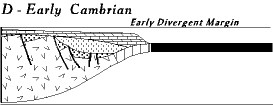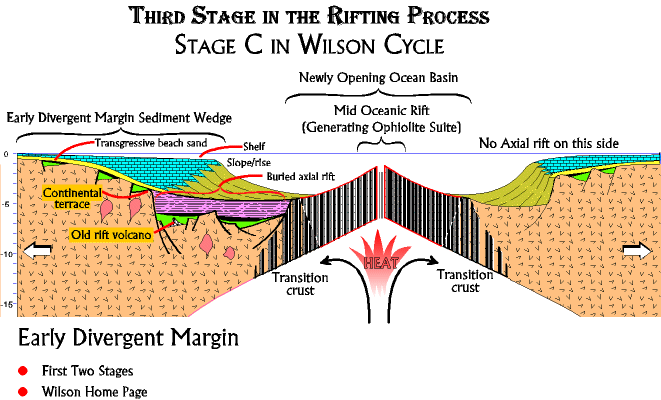 Cross Section
D (Next Cross Section) (Previous Cross Section) (Home) Early Divergent Continental Margin Early Cambrian; 560 - 550 mya  The final smoothing out of the rift margin is preserved in the Chilhowee group, containing three formations, Weverton, Harpers, and Antietam, found on both flanks of the Blue Ridge (NW cross section; SE cross section). Note that these formation, sometimes with different names, are found all up and down the Mid-Atlantic region. The Weverton and Harpers formations contain evidence of river and submarine fan deposits, and are the final filling stages of the graben.  The early DCM officially begins when the edge of the continent finally subsides below sea level. This transition is marked in the stratigraphic record by the Antietam formation, a beach deposit of quartz sandstone, that began to migrate, or transgress, across the continent with the subsidence of the continental edge. The transgression will end in Wisconsin in about 100 million years. In the third rift cross section the Antietam is represented by the thin yellow bed labeled "transgressive beach sand." You can see here that it is already below sea level. The early DCM officially begins when the edge of the continent finally subsides below sea level. This transition is marked in the stratigraphic record by the Antietam formation, a beach deposit of quartz sandstone, that began to migrate, or transgress, across the continent with the subsidence of the continental edge. The transgression will end in Wisconsin in about 100 million years. In the third rift cross section the Antietam is represented by the thin yellow bed labeled "transgressive beach sand." You can see here that it is already below sea level. In this more detailed reconstruction of the Proto-Atlantic DCM, the continental terrace has just subsided below sea level and the Antietam transgressive beach is being actively deposited. So, at the end of the rifting, and the beginning of the DCM, standing there and looking around would reveal a broad, flat, featureless continent stretching off endlessly to the west, and the broad flat Proto-Atlantic ocean to the east (D2). This is the picture in the DCM 3rd rift cross section. Notice that the axial rift is now below sea level, buried under a thin accumulation of sediment. Also notice that directly on top of the Antietam formation are carbonate rocks (brick patterns always indicate carbonates) of the Shady formation. This rapid transition from pure quartz sandstone to carbonates, without intervening shale, is an indication of how quickly the rift stage stabilized into the early divergent continental margin. And the stabilization is only going to continue for the next hundred millioin years or so in Stage E.
|